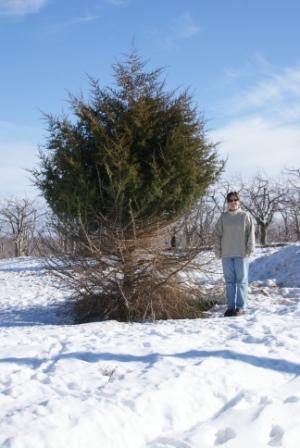Last week Holly and I extolled the virtues of our dogs for helping to keep our gardens and landscapes relatively deer-free even though we live in areas with high deer pressure. Of course, letting dogs roam your property is not an option for everyone. So what are some other options to keep deer from turning your garden into a salad buffet?

My former grad student, Sara Tanis, shows off deer damage at her parent’s place near Ludington, MI
One of the most popular non-canine deer remedies is applying various deer repellants. Typically I’ve been pretty skeptical of deer repellants. Trying to stop hungry deer from chowing down on your garden is like trying to stop a high school football team from devouring an all-you-can-eat pizza buffet. Recently, however, I saw some results from some colleagues at North Carolina State University on the effectiveness of various deer repellents in Christmas tree plantations that looked promising. Deer damage is a major issue in Christmas trees; deer browse pressure can be very high on conifers since they may be the most palatable thing available to deer in the winter. Research at NCSU and other studies (Wagner and Nolte 2001, Wildlife Soc. Bull.29:322-330) indicate that repellants that contain putrescent egg solids or animal protein can be effective at reducing deer damage. Of course, no repellant is 100% effective. If they’re hungry enough and don’t have an alternative, deer will likely overcome their fear of these scents and still come in for a nibble. Also repellants need to be re-applied periodically to be effective. Nevertheless, for gardener’s at their wit’s end and ready to resort to high velocity lead, repellants may be a better alternative. Although Sara says lead works too!

Bert,
Did the study include products (like Tree Guard) that contain Bitrex? I have been using Tree Guard in my whitetail testing ground with very good results. The bunnies hate it too, so it saves my woodies and my hostas, tulips etc. Only negative is that it is pricey and also uglies up fuzzy-leaved plants.
This U of MD publication:
http://extension.umd.edu/publications/PDFs/EB354-C.pdf
has the most thorough summaries of the various methods of managing deer that I’ve come across.
You can watch a free, recorded 1 hour webinar here:
http://www.naturalresources.umd.edu/ResourcesWebinars.html#Deer
Speakers are Jonathan Kays, Extension Natural Resources Specialist (author of the referenced publication above), and George Timko, Deer Biologist with the MD DNR Wildlife Division.
This is not new information even if it’s a new study. Weyerhauser has been using putrified egg based repellent for at least 2 decades and over that time I’ve seen numerous studies that invariably have shown egg based repellents to be the most affective.
I own a bearing age fruit tree nursery in southeastern NY and I have no fence to exclude deer which run through my property in small herds.
I make my own repellent by running eggs through a blender and mixing them with a bar of ivory soap I’ve liquified.
I let the eggs get putrid and mix a couple eggs worth of the mix and a good sticker per gallon of water.
It stops the deer from killing my trees but as soon as enough no growth appears the deer do begin chowing down so bi-weekly sprays are needed during the growing season.